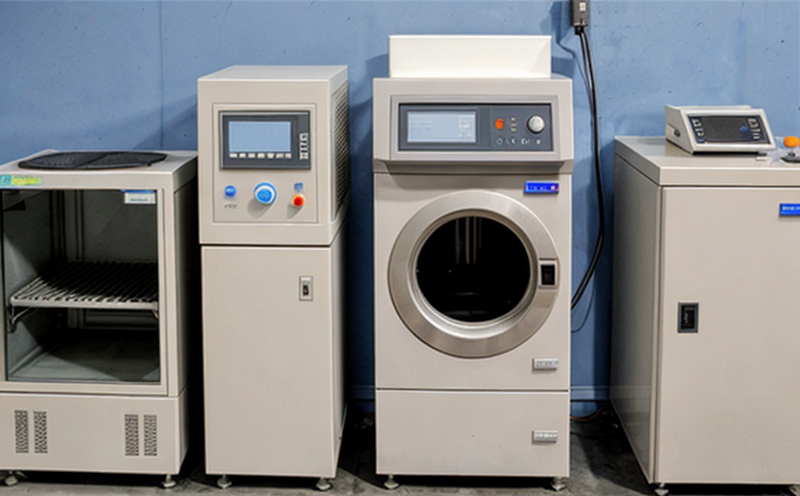DIN EN 15051 Dustiness and Dispersion Potential of Nanoparticles in Air
The DIN EN 15051 standard is a crucial tool for ensuring the safe handling, dispersion, and use of nanomaterials. This test evaluates the dustiness and potential to disperse nanoparticles into air, which is particularly important given the unique properties that nanomaterials exhibit in their small particle form.
The primary aim of DIN EN 15051 is to provide a standardized method for determining how easily nanoparticles can be released from materials during processing or use. This is critical because even minute quantities of dustiness and dispersion can pose significant health risks if not controlled properly, especially in industries like electronics, pharmaceuticals, and manufacturing.
The test measures the ability of nanomaterials to generate airborne particles that could potentially be inhaled by workers or spread into the environment. By understanding this potential, manufacturers and researchers can take necessary precautions to mitigate risks associated with exposure.
The testing process involves exposing a known quantity of nanoparticles to air flow for a specified period under controlled conditions. The amount of dust generated is then measured using gravimetric techniques or optical particle counters. This allows for quantification of the dustiness and dispersion potential, providing valuable data that informs safety protocols.
Understanding these properties is essential not only from an occupational health and safety perspective but also from a regulatory standpoint. Regulatory bodies often require compliance with standards like DIN EN 15051 to ensure products are safe for both workers and the environment. This test helps companies meet these requirements, ensuring they can confidently bring their nanomaterial-based products to market.
Moreover, this testing is not just about safety; it also plays a vital role in optimizing production processes. By knowing how easily nanoparticles will disperse into air, manufacturers can design better containment systems and operational procedures that reduce the likelihood of unwanted releases. This leads to more efficient operations with less risk.
It's important to note that DIN EN 15051 applies specifically to solid materials containing nanomaterials intended for processing or use where there is a potential for release into air. This includes powders, granules, and other forms of solid materials. The standard does not cover liquids or gases directly; however, the principles derived from this testing can be extended to these contexts with appropriate modifications.
The testing process itself involves several key steps. First, the sample is prepared according to specified methods outlined in the standard. This preparation ensures consistency across different samples and tests. Next, the sample is exposed to a controlled air flow for a set duration. During this time, any dust or particles that are released into the air are captured using specialized equipment.
The captured material is then analyzed either by weight loss (gravimetrically) or through optical particle counting techniques. These methods provide precise measurements of the amount and size distribution of the dust generated during testing. The results give a clear picture of the dustiness and dispersion potential of the nanomaterial.
From an occupational health and safety perspective, these tests are indispensable in industries where nanomaterials are used extensively. For instance, in electronics manufacturing, ensuring that nanoparticles do not easily generate airborne particles is crucial for maintaining clean room environments and protecting workers from potential respiratory hazards.
In pharmaceutical applications, understanding the dustiness of nanoparticle-based drugs helps ensure they can be safely handled during production without risking contamination or inhalation by personnel. Similarly, in manufacturing processes involving nanomaterials, such as coatings or composites, knowing their dispersion characteristics is vital for optimizing production efficiency and safety.
In conclusion, DIN EN 15051 provides a robust framework for assessing the dustiness and dispersion potential of nanoparticles. This knowledge empowers industries to manage risks effectively, comply with regulations, and innovate safely in their use of nanomaterials.
Why It Matters
The importance of DIN EN 15051 cannot be overstated. This test is pivotal for several reasons:
- Occupational Health and Safety: By identifying the dustiness and dispersion potential, workplaces can implement appropriate safety measures to protect employees from inhalation hazards.
- Regulatory Compliance: Many jurisdictions require compliance with such standards. Failure to meet these requirements could lead to legal issues or product recalls.
- Risk Mitigation: Understanding the potential for nanoparticle release allows businesses to minimize risks associated with exposure, leading to safer working environments and processes.
- Innovation and Process Optimization: Insights gained from testing can help refine production methods, improve product design, and enhance overall efficiency in handling nanomaterials.
Why Choose This Test
Selecting DIN EN 15051 for dustiness and dispersion potential testing offers numerous advantages:
- Achieving Safety Standards: The test ensures that products meet stringent safety standards, thereby protecting workers and the environment.
- Enhanced Reputation: Compliance with internationally recognized standards like DIN EN 15051 can significantly enhance a company's reputation in the market.
- Regulatory Assurance: It provides assurance that products comply with relevant regulations, potentially avoiding costly legal challenges or product recalls.
- Data for Innovation: The test results offer valuable data that can drive innovation and process improvements within the organization.
International Acceptance and Recognition
- The DIN EN 15051 standard is widely accepted in Europe, aligning with other international standards such as ISO 13789 for dustiness of powders.
- It is recognized by regulatory bodies across Europe and is often used in conjunction with other tests to ensure comprehensive safety assessments.
- The standard's acceptance extends beyond Europe; it is also utilized in other regions that prioritize occupational health and safety, such as North America and Asia.





